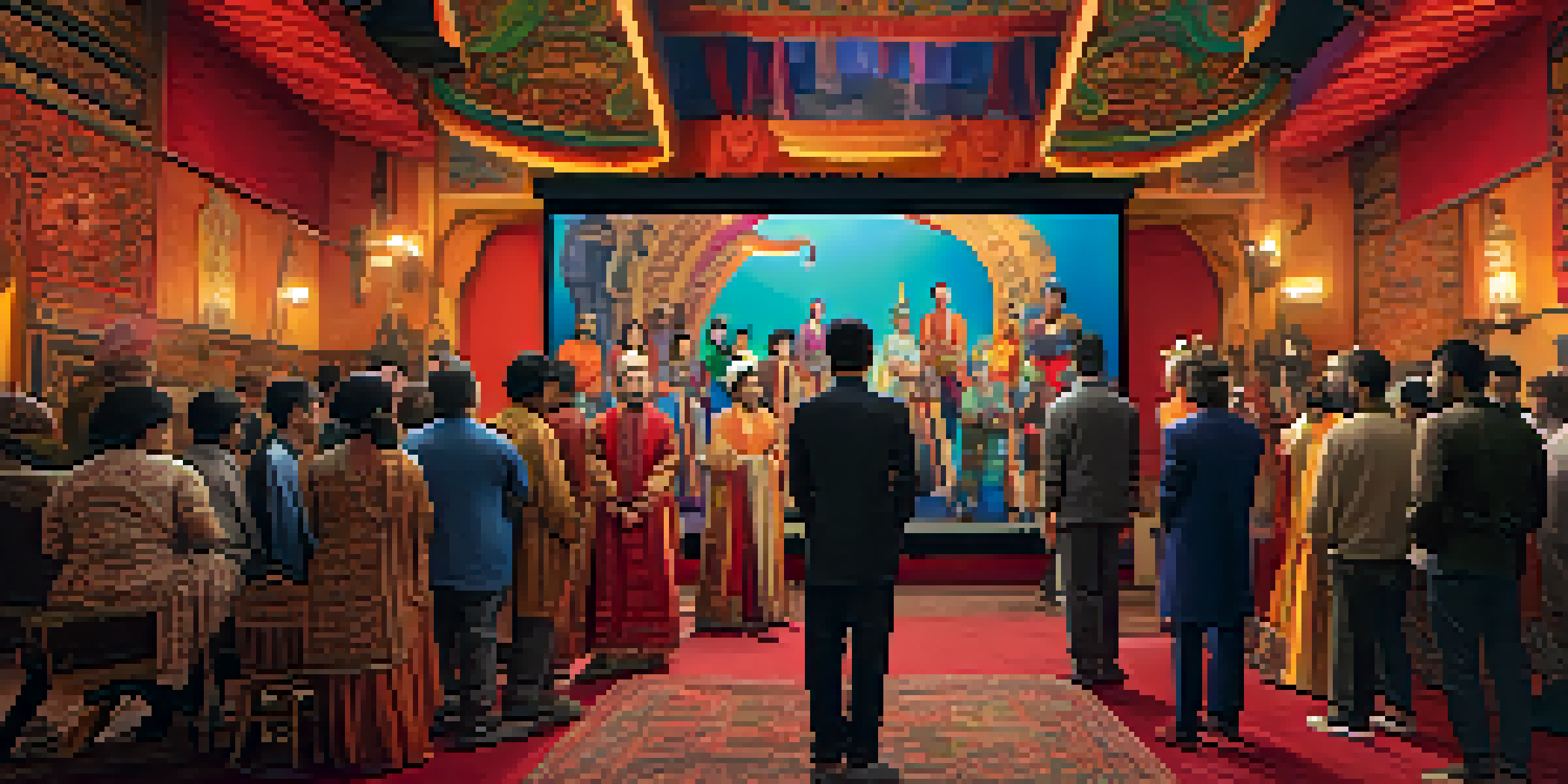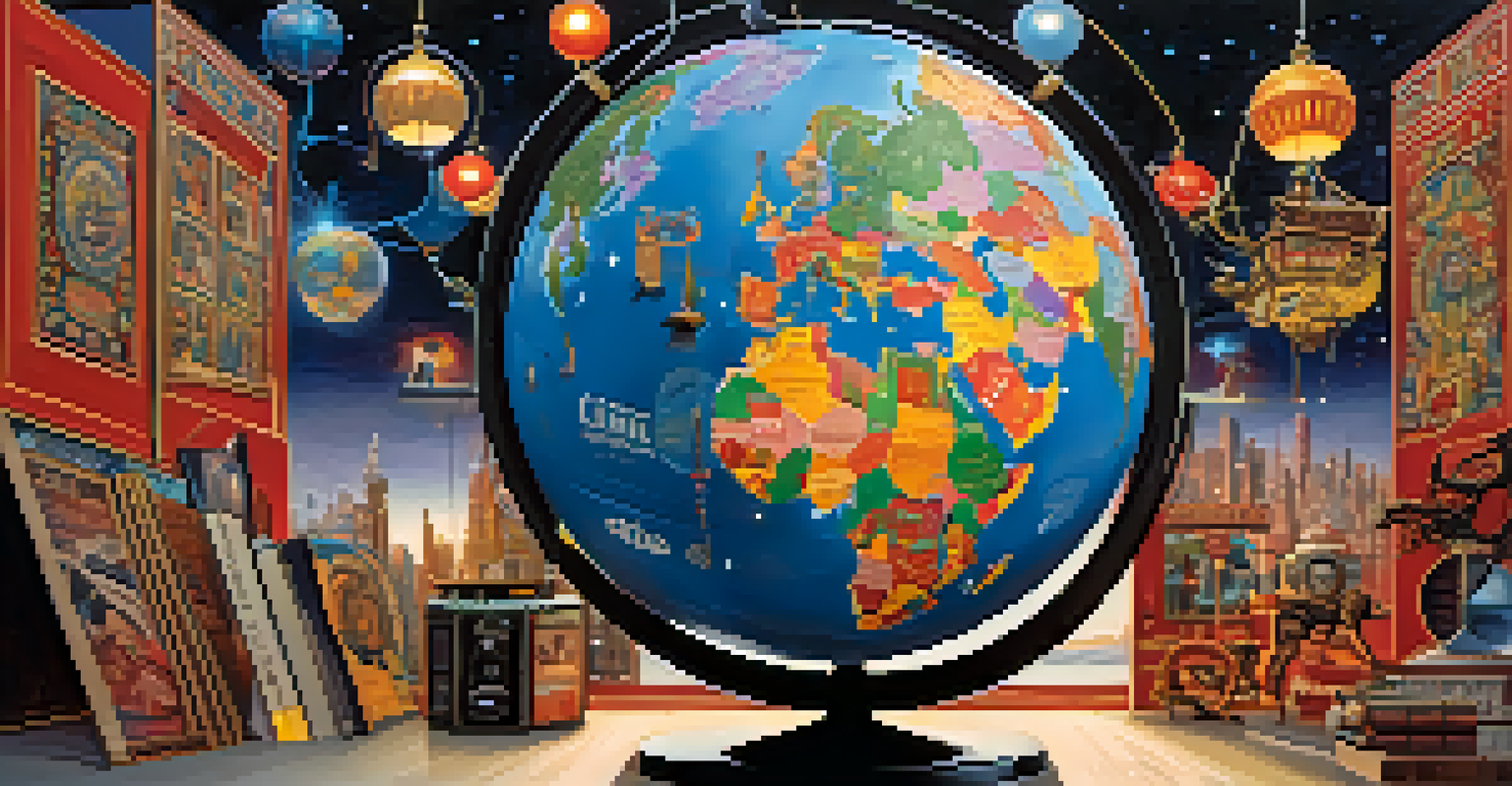Cross-Cultural Collaborations: Hollywood's Global Partnerships

Understanding Cross-Cultural Collaborations in Film
Cross-cultural collaborations in film refer to partnerships between filmmakers from different countries. These collaborations often bring unique stories and perspectives to the big screen, creating a richer tapestry of narratives. By combining different cultural elements, filmmakers can engage a broader audience and foster greater understanding among diverse communities. This practice not only enhances creativity but also promotes cultural exchange and appreciation.
The beauty of cinema is that it transcends borders and connects us all through storytelling.
In a world that is increasingly interconnected, such partnerships have become essential. They allow filmmakers to share resources, talent, and technology, leading to innovative storytelling techniques. For instance, when filmmakers from Asia collaborate with Hollywood studios, they often merge traditional storytelling with cutting-edge technology. This fusion can result in visually stunning films that appeal to both local and international audiences.
Moreover, these collaborations can help break down stereotypes and challenge preconceived notions about different cultures. By showcasing authentic voices and stories, they encourage audiences to explore and appreciate cultural diversity. In a way, cross-cultural collaborations act as a bridge, connecting people from different backgrounds through the universal language of film.
Hollywood's Global Influence and Cultural Exchange
Hollywood has long been a dominant force in the global film industry, influencing storytelling and production standards around the world. This influence has paved the way for cultural exchange, where filmmakers and actors from various countries collaborate to create compelling content. The fusion of different cultural elements not only enriches the storytelling but also resonates with a wider audience, making films more relatable and appealing.

Take, for example, the collaboration between American filmmakers and Indian cinema. Films like 'Slumdog Millionaire' not only garnered critical acclaim but also showcased the vibrancy of Indian culture to a global audience. Such collaborations highlight the potential for storytelling that transcends geographical boundaries while celebrating cultural uniqueness.
Cultural Exchange Enhances Storytelling
Cross-cultural collaborations in film enrich narratives by blending diverse cultural elements and perspectives.
As Hollywood continues to seek fresh narratives, it increasingly turns to international partners for inspiration. This not only diversifies the types of stories being told but also fosters a sense of global community. Ultimately, the blending of cultures in cinema can lead to powerful narratives that reflect the complexities of our interconnected world.
Key Examples of Successful Cross-Cultural Films
Many films have successfully highlighted the power of cross-cultural collaboration, serving as prime examples of this trend. One notable instance is 'Crouching Tiger, Hidden Dragon,' a film that brought Chinese martial arts cinema to mainstream audiences worldwide. This film not only showcased stunning visuals and choreography but also introduced audiences to rich Chinese cultural themes and philosophies.
Film is a universal language. It speaks to the heart and the imagination, bringing people together from different cultures.
Another example is 'The Farewell,' which beautifully navigates the complexities of family dynamics across cultures. By blending American and Chinese storytelling styles, the film resonated with a diverse audience and sparked conversations about identity and belonging. Such films exemplify how cross-cultural collaborations can lead to authentic storytelling that speaks to universal experiences.
These examples illustrate that when filmmakers harness the strengths of different cultures, the result can be both artistically rewarding and commercially successful. This trend continues to inspire filmmakers to explore new narratives, leading to an exciting evolution in the global film landscape.
Challenges Faced in Cross-Cultural Collaborations
While cross-cultural collaborations can yield remarkable results, they also come with their own set of challenges. Language barriers, for instance, can complicate communication between filmmakers from different backgrounds. Misunderstandings may arise, leading to potential conflicts in the creative process. To mitigate these issues, clear communication and mutual respect are essential.
Cultural differences can also pose challenges, as filmmakers may have varying approaches to storytelling and production. For example, the pacing of a film or the portrayal of certain themes may differ significantly between cultures. Navigating these differences requires flexibility and a willingness to embrace diverse perspectives, ultimately enriching the final product.
Technology Facilitates Global Films
Advancements in technology enable filmmakers to connect and collaborate seamlessly across borders, enhancing creative expression.
Furthermore, there can be concerns about cultural appropriation, where elements of one culture are used without proper understanding or respect. Filmmakers must be mindful of representing cultures authentically and ethically. By fostering collaboration that prioritizes cultural sensitivity, filmmakers can create work that honors the richness of diverse traditions.
The Role of Technology in Global Collaborations
In today's digital age, technology plays a crucial role in facilitating cross-cultural collaborations. Advanced communication tools enable filmmakers from different parts of the world to connect and collaborate seamlessly. Video conferencing, cloud-based editing software, and social media platforms have made it easier than ever to share ideas and resources across borders.
Additionally, technology allows for innovative storytelling techniques that can blend different cultural elements. For instance, virtual reality and augmented reality are being used to create immersive experiences that bring diverse stories to life. This technological advancement not only enhances viewer engagement but also opens up new avenues for creative expression.
As technology continues to evolve, it will undoubtedly shape the future of cross-cultural collaborations in filmmaking. By leveraging these tools, filmmakers can push the boundaries of storytelling, creating films that reflect the richness of our global society while appealing to diverse audiences.
Future Trends in Cross-Cultural Cinema
As the film industry continues to evolve, cross-cultural collaborations are expected to become more prevalent. With globalization and increased access to international markets, filmmakers are recognizing the value of diverse storytelling. This trend is likely to lead to a greater variety of narratives that reflect the complexities of our interconnected world.
We may also see more co-productions between Hollywood and international filmmakers, resulting in films that authentically represent multiple cultures. This could lead to the emergence of new genres and styles that blend various cultural influences. Such innovations promise to enrich the cinematic landscape, making it more vibrant and inclusive.
Future of Film Embraces Diversity
The trend towards cross-cultural cinema is expected to grow, leading to more inclusive stories and representation in filmmaking.
Moreover, the rise of streaming platforms has created new opportunities for cross-cultural collaborations. These platforms are eager to showcase diverse content, reaching audiences around the globe. As a result, filmmakers can experiment with unique narratives and styles, paving the way for a future where cross-cultural cinema thrives.
Conclusion: Embracing Diversity in Film
Cross-cultural collaborations in Hollywood are not just a trend; they represent a fundamental shift in how stories are told and shared. By embracing diverse voices and perspectives, filmmakers can create work that resonates with audiences around the globe. This commitment to inclusivity enriches the cinematic experience and fosters a deeper understanding of our shared humanity.
As we move forward, it's essential to continue advocating for diverse representation in all aspects of filmmaking. This includes not only the stories being told but also the voices behind the camera. By promoting collaboration and cultural exchange, the film industry can cultivate a rich tapestry of narratives that reflect the world we live in.

In conclusion, the future of cinema lies in its ability to embrace diversity. As Hollywood continues to forge global partnerships, we can look forward to a more inclusive and vibrant film landscape that celebrates the beauty of cultural collaboration.